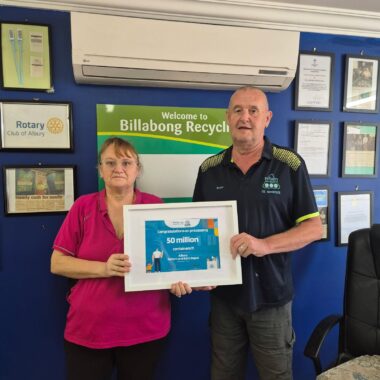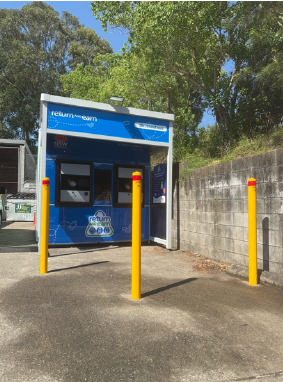Holcim, Scania and HYDI are partnering to decarbonise the logistics chain in Australia’s remote north-west.
The Pilbara is a vast region of endless red landscapes, twice the size of Great Britain, located in the north of Western Australia. To move road freight more efficiently over such long distances trucks with multiple trailers, known as road trains, are a common sight across remote regions of Australia.
Holcim Australia uses road trains to transport quarry materials from the Turner River, Newman and Nickol Bay quarries in the Pilbara region to fixed and mobile concrete batch plants and other customers using Scania R620 V8 Euro 5 145-ton rated prime movers. Each road train pulls a payload of up to 100 tons in triple (three-trailer) configurations, on haul distances from as little as 10 km, up to 600 km.
To help advance Holcim’s ambition to reduce Scope 3 emissions by reducing diesel consumption and emissions, two prime movers were retrofitted with a HYDI Hydrogen on Demand HY2500 vertical unit that produces hydrogen on demand for controlled delivery to internal combustion engines.
Holcim has seen reductions in fuel consumption of up to 15%. This is only part of the benefit of the hybrid system explains Adam Evans, Logistics Manager for Aggregates Western Australia at Holcim. “On top of the fuel consumption figures, excitingly, we’re seeing the additional emission reductions of 17% less carbon dioxide (CO2), 80% lower diesel particulate matter (DPM), 22% lower nitrogen oxides (NOX), and 25% lower carbon monoxide (CO),” he noted.
“Holcim has seen fuel performance savings estimated at 15% when hauling payloads up to 100-tonnes in three-trailer combinations. The Scania onboard management system confirms these figures. The reductions in fuel burn and reductions in emissions, is entirely in line with our aim at Scania to reduce emissions during the entire working lives of our products,” says Robert Taylor, Scania Australia General Manager, Mining.
Holcim is set to install HYDI systems in two additional prime movers as well as some of its contractor fleet throughout Western Australia. “We are also exploring options to have HYDI units installed on other equipment including diesel generators and heavy mining equipment,” said Adam Evans.
The HYDI unit produces hydrogen from distilled water using electrolysis via a proton exchange membrane. The unit draws a low electrical input from the host engine while in operation. Hydrogen supplements the diesel fuel to create a cleaner and more complete combustion process with the amount of hydrogen produced optimised for the capacity and application of the engine.
Developed in Australia over more than a decade, the leading-edge technology delivers improved machinery performance by increasing torque, a reduction in fuel consumption, cleaner burn that reduces engine soot and extends oil and filter service intervals, and lower harmful emissions – including DPM, CO2 and CO. The system provides the capability to transition heavy, diesel-powered machinery into cleaner, more cost-efficient equipment at a fraction of the cost of replacement.
“HYDI’s technology harnesses the benefits of hydrogen in an efficient, affordable and sophisticated way scaled to apply to multiple applications,” noted John Wilson, Managing Director of HYDI.
Scania has been a committed and enthusiastic partner in the trial and are honouring the original repair and maintenance package provided with the vehicles. “Scania stepped up to the project, made sure we had all the vehicle and system information needed for a smooth installation of the HYDI units, and are eager to help us extend the project even further,” said Adam Evans.
The HYDI Hydrogen on Demand system can be simply, quickly and relatively inexpensively integrated into the existing diesel technology of Scania vehicles. “In Australia we have to say that realistically the general availability of reliable, affordable hydrogen as a fuel for heavy haulage is still some way off, particularly regarding use in remote mining operations. As a result, the HYDI Hydrogen on Demand solution does appear to be providing a real-world and affordable solution for our customers who want or need to make an immediate reduction in fuel burn and their carbon footprint emissions across their transport functions,” says Scania’s Robert Taylor.
The investment and installation of this leading-edge transitional technology into our fleet further highlights Holcim’s commitment to reduce its Scope 3 emissions on our journey to reducing absolute Scope 3 Greenhouse Gas (GHG) emissions 90% by 2050 from a 2020 base year1.
ENDS
1 https://www.holcim.com/sustainability/climate-action
About us:
About Holcim:
Holcim builds progress for people and the planet. As a global leader in innovative and sustainable building solutions, Holcim is enabling greener cities, smarter infrastructure and improving living standards around the world. With sustainability at the core of its strategy Holcim is becoming a net zero company, with its people and communities at the heart of its success. Holcim Australia is a leading supplier of aggregates, concrete, and precast concrete products: https://www.holcim.com.au/.
Contact details:
Claire Hartley
Head of Brand and Communications
Holcim Australia and New Zealand
Mobile: +61 488 249 240 | Email: [email protected]


